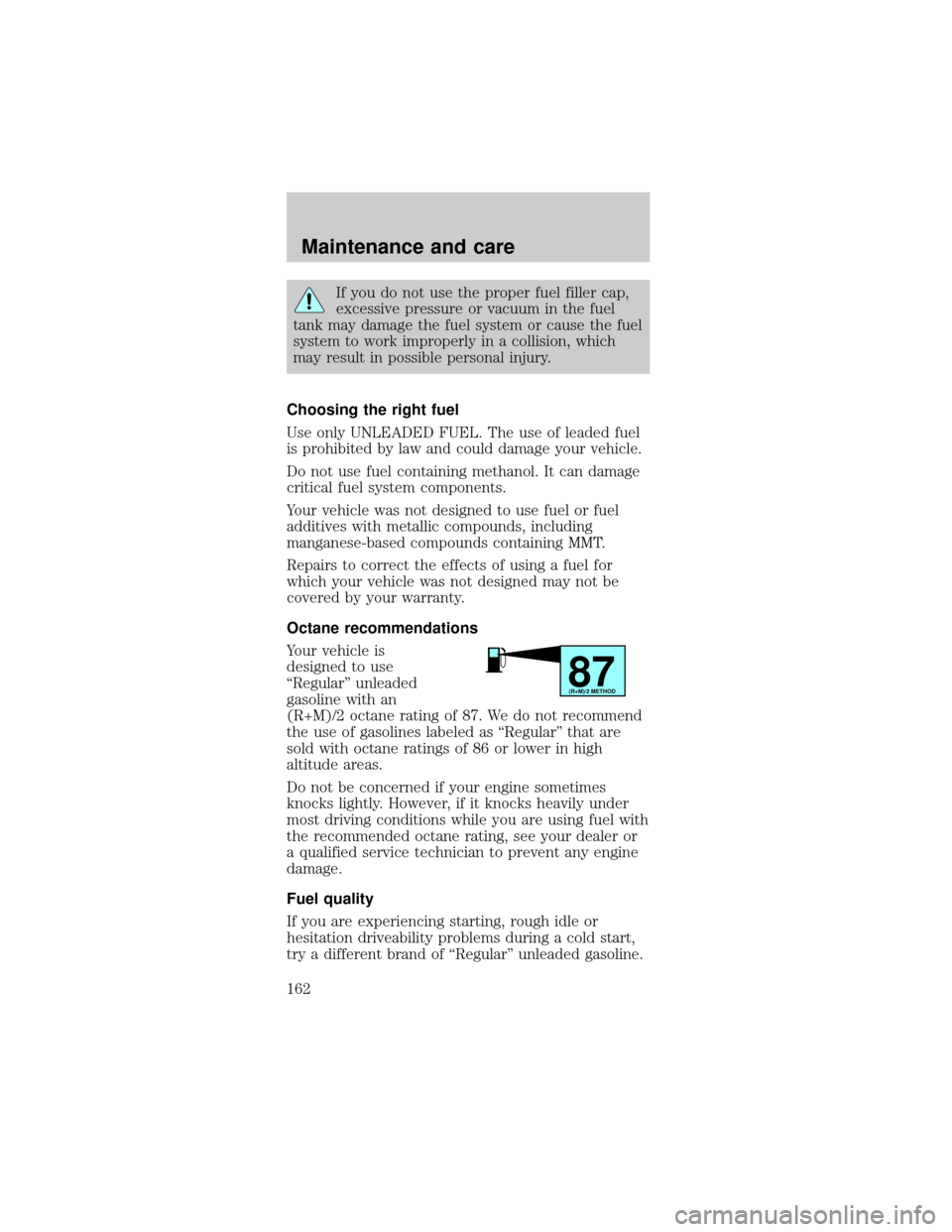1999 FORD MUSTANG air condition
[x] Cancel search: air conditionPage 130 of 216

SERVICE RECOMMENDATIONS
To help you service your vehicle:
²We highlight do-it-yourself items in the engine
compartment for easy location.
²We provide a Scheduled Maintenance Guide which
makes tracking routine service easy.
If your vehicle requires professional service, your
dealership can provide necessary parts and service.
Check your ªWarranty Guideº to find out which parts
and services are covered.
Use only recommended fuels, lubricants, fluids and
service parts conforming to specifications. Motorcraft
parts are designed and built to provide the best
performance in your vehicle.
PRECAUTIONS WHEN SERVICING YOUR
VEHICLE
Be especially careful when inspecting or servicing
your vehicle.
²Do not work on a hot engine.
²When the engine is running, keep loose clothing,
jewelry or long hair away from moving parts.
²Do not work on a vehicle with the engine running
in an enclosed space, unless you are sure you
have enough ventilation.
²Keep all lit cigarettes, open flames and other lit
material away from the battery and all fuel related
parts.
If you disconnect the battery, the engine must
ªrelearnº its idle conditions before your vehicle will
drive properly, as explained in theBatterysection in
this chapter.
Working with the engine off
²Automatic transmission:
1. Set the parking brake and ensure the gearshift is
securely latched in P (Park).
Maintenance and care
130
Page 162 of 216

If you do not use the proper fuel filler cap,
excessive pressure or vacuum in the fuel
tank may damage the fuel system or cause the fuel
system to work improperly in a collision, which
may result in possible personal injury.
Choosing the right fuel
Use only UNLEADED FUEL. The use of leaded fuel
is prohibited by law and could damage your vehicle.
Do not use fuel containing methanol. It can damage
critical fuel system components.
Your vehicle was not designed to use fuel or fuel
additives with metallic compounds, including
manganese-based compounds containing MMT.
Repairs to correct the effects of using a fuel for
which your vehicle was not designed may not be
covered by your warranty.
Octane recommendations
Your vehicle is
designed to use
ªRegularº unleaded
gasoline with an
(R+M)/2 octane rating of 87. We do not recommend
the use of gasolines labeled as ªRegularº that are
sold with octane ratings of 86 or lower in high
altitude areas.
Do not be concerned if your engine sometimes
knocks lightly. However, if it knocks heavily under
most driving conditions while you are using fuel with
the recommended octane rating, see your dealer or
a qualified service technician to prevent any engine
damage.
Fuel quality
If you are experiencing starting, rough idle or
hesitation driveability problems during a cold start,
try a different brand of ªRegularº unleaded gasoline.
87(R+M)/2 METHOD
Maintenance and care
162
Page 166 of 216

Driving style Ð good driving and fuel economy
habits
Give consideration to the lists that follow and you
may be able to change a number of variables and
improve your fuel economy.
Habits
²Smooth, moderate operation can yield up to 10%
savings in fuel.
²Steady speeds without stopping will usually give
the best fuel economy.
²Idling for long periods of time (greater than one
minute) may waste fuel.
²Anticipate stopping; slowing down may eliminate
the need to stop.
²Sudden or hard accelerations may reduce fuel
economy.
²Slow down gradually.
²Driving at reasonable speeds (traveling at 88 km/h
[55 mph] uses 15% less fuel than traveling at
105 km/h [65 mph]).
²Revving the engine before turning it off may
reduce fuel economy.
²Using the air conditioner or defroster may reduce
fuel economy.
²Using speed control (if equipped) may improve
fuel economy. Speed control can help maintain a
constant speed and reduce speed changes. You
may want to turn off the speed control in hilly
terrain as unnecessary shifting between third and
fourth gears may occur and could result in
reduced fuel economy.
²Warming up a vehicle on cold mornings is not
required and may reduce fuel economy.
²Resting your foot on the brake pedal while driving
may reduce fuel economy.
Maintenance and care
166
Page 201 of 216

complement the style and aerodynamic appearance
of your vehicle. In addition, each accessory is made
from high quality materials and meets or exceeds
Ford's rigid engineering and safety specifications.
Ford accessories are warranted for up to 12 months
or 20,000 km (12,000 miles) on all cars and light
trucks and 12 months with unlimited distance on
medium/heavy duty trucks unless the accessory is
installed on a new vehicle, then the warranty
becomes the balance of the new vehicle's warranty
or the accessories warranty, whichever is greater.
See your dealer for complete warranty information
and availability.
Not all accessories are available for all models.
Vehicle Security
Remote keyless entry
Styled wheel protector locks
Vehicle security systems
Comfort and convenience
Air conditioner
Air filtration systems
Cargo nets
Cargo organizers
Cargo shades
Cargo trays
Dash trim
Engine block heaters
Gear shift knob
Luggage presenter (Continental only)
Manual sliding rear window
Tire step
Customer assistance
201
Page 207 of 216

Air bag supplemental
restraint system ........ 74
and child
safety seats ............. 76
description .............. 74
disposal .................... 79
driver air bag .......... 77
indicator light ...... 7,78
operation ................. 77
passenger air bag ... 77
Air cleaner filter ..... 182
Air conditioning ........ 18
manual heating
and air conditioning
system ..................... 18
Anti-theft
system .............. 60,61,62
warning light ............. 7
Automatic
transmission .............. 97
driving an automatic
overdrive ................. 98
fluid,
refill capacities ...... 183
fluid,
specification .......... 188
Axle
lubricant
specifications ........ 188
refill capacities ...... 183
traction lok ............ 105
Battery ..................... 150
acid, treating
emergencies .......... 150
charging system
warning light ............. 7
jumping a disabled
battery ................... 123
maintenance-free .. 150
replacement,
specifications ........ 182
servicing ................ 150voltage gauge .......... 15
Brakes ................... 92,94
anti-lock .............. 92,93
anti-lock brake
system (ABS)
warning light ...... 10,93
brake
warning light ........... 10
fluid, checking
and adding ............ 137
fluid,
refill capacities ...... 183
fluid,
specifications . 185,188
lubricant
specifications . 185,188
parking .................... 94
shift interlock .......... 97
Break-in period ........... 2
Capacities for
refilling fluids .......... 183
Child safety
restraints ................... 80
child safety belts .... 80
child safety seats .... 81
Child safety seats ...... 81
attaching with
tether straps ........... 85
built-in child seat ... 81
in front seat ............ 83
in rear seat .............. 83
tether anchorage
hardware ................. 85
Cleaning
your vehicle ............. 176
engine
compartment ......... 178
exterior ........... 178,181
exterior lamps ....... 179
instrument panel .. 180
interior ................... 180
plastic parts .......... 179
Index
207
Page 209 of 216

Fluid capacities ....... 183
Foglamps ................... 53
Fuel .......................... 158
calculating fuel
economy ................ 164
cap ......................... 161
capacity ................. 183
choosing
the right fuel ......... 162
comparisons with
EPA fuel economy
estimates ............... 168
detergent in fuel ... 163
filling your vehicle
with fuel .. 158,161,164
filter,
specifications . 163,182
fuel pump shut-off
switch .................... 112
gauge ....................... 12
improving fuel
economy ................ 164
low fuel
warning light ............. 9
octane rating .. 162,188
quality .................... 162
running
out of fuel ............. 163
safety information
relating to
automotive fuels ... 158
Fuses ................. 113,114
Gas cap
(see Fuel cap) ......... 161
Gas mileage(see
Fuel economy) ........ 164
Gauges .................. 11,12
battery voltage
gauge ....................... 15
engine coolant
temperature gauge . 12engine oil pressure
gauge ....................... 15
fuel gauge ................ 12
odometer ................. 13
speedometer ........... 13
tachometer .............. 14
trip odometer .......... 14
GAWR (Gross Axle
Weight Rating) ........ 106
definition ............... 106
driving with
a heavy load .......... 106
location .................. 106
GVWR (Gross Vehicle
Weight Rating) ........ 106
calculating ............. 106
definition ............... 106
driving with
a heavy load .......... 106
location .................. 106
Hazard flashers ....... 112
Head restraints ......... 64
Headlamps ................. 16
aiming ............. 175,176
bulb
specifications ........ 175
daytime
running lights .......... 16
flash to pass ............ 45
high beam ............ 7,45
turning on and off .. 16
warning chime ........ 11
Heating ...................... 18
heating and air
conditioning
system ..................... 18
Hood ........................ 132
Ignition ..................... 188
positions of the
ignition .................... 45
removing the key .. 105
Index
209